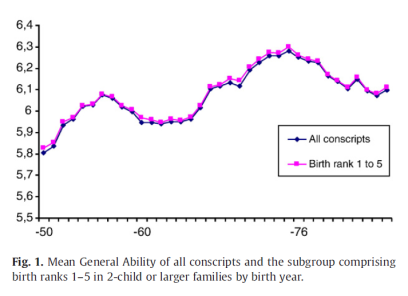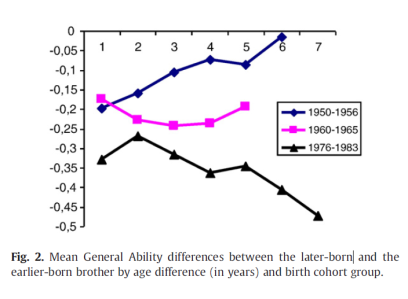IQ and Birth Order Effects: Real? No
One of the greatest pieces of evidence demonstrating that the family/rearing environment has no effect on eventual outcomes is the absence of birth order effects. Birth order is an excellent test for these effects: it is something that systematically differs between siblings and is bona fide non-genetic (mostly). Hence, it’s a great way to see if childhood environment leaves any sort of mark on people.
And it turns out that it does not. The study of birth order has been marred with poor research – faulty because it relies on the Standard Social Science Method:
This has prevented us from separating any putative causal effects of birth order from genetic confounds – most notably, the tendency of less intelligent/educated parents to have larger families. However, some decent research has been conducted demonstrating the absence of these birth order effects. One is an adoption study (Beer & Horn, 2000), which goes into good detail on the problems with birth order research and ways around these problems. They looked at adoptees from the Texas Adoption Project and the Colorado Adoption Project and found only tiny and statistically insignificant effects of birth order on personality traits. Another (tiny, N = 69 pairs) study looked within sibships for birth order effects on personality and found none (Blesk-Rechek & Kelly, 2015). A big review of the claims of Frank Sulloway (a major proponent of birth order effects) by Frederic Townsend (2000) also found no birth order effects on personality or on “rebellious” actions (as claimed by Sulloway).
But, perhaps better than these is a whole-population study out of Norway (Black, Devereux, & Salvanes, 2005). Unfortunately, this is a SSSM study, but its enormous size makes it invaluable for evaluating potential birth order effects. They performed an analysis of birth order controlling for family size as well as a within-family analysis of the effects of birth order on educational attainment. They did find modest but significant effects on educational attainment, with later-borns achieving less than earlier-borns – but I will return to this point. However, this study is useful because in addition to education, they looked at various real world outcomes, like income and likelihood of teenage pregnancy. Here, they found statistically significant but extremely small effects of birth order, with the birth order correlations of -0.04 or even closer to 0. This means birth order would explain less than 2 X 10^-5 worth of the variance – and this is without controlling for family size.
So we don’t see birth order effects on personality or important life outcomes. But some recent studies claimed to find a birth order effect on IQ of all things.
One large study of Norweigan conscripts (Bjerkedal et al, 2007) claimed to find a birth order effect on IQ within families between brothers. Younger brothers scored lower than their older brothers. The effect was small (less than 4 IQ points), but owing to the very large sample, significant.
It gets better. Another very recent study (Barclay, 2015) claimed to find a birth order effect on education with a large sample (N > 6000) of adoptees in Sweden. Again, the effects were small, and even with this large sample, only just barely statistically significant.
So there you have it. Have we found real birth order effects after all? An environmental one at that, as some have suggested? Well, if you’ve been following this blog, you’ll know I’m going to say not so fast.
First of all, these putative effects – where they’re found at all – are all tiny. That itself is a red flag – one that demands we subject it to closer scrutiny. Now, there’s nothing saying that extremely tiny effects can’t exist, but it is suspicious. But these findings come from very large samples, so we can’t dismiss them off-hand.
So what else could be going on here? It has been said that these birth order effects could be the result of the Flynn effect. This would mean that there’s no real change in intelligence by birth order, merely systematic variation in test scores, along what whatever it is that drives the Flynn effect. Indeed, one study seem to show exactly that.
Sudet et al 2010 looked at those Norwegian conscripts and studied the trends in the Flynn effect in Norway at the time. The Flynn effect wasn’t undergoing a monotonic increase but rather stalled at times and as of late has been reversing.
Notice the pattern? Birth order effects track the direction of the Flynn effect in Norway during this time. When the Flynn effect tracked upward, the difference between brothers decreased with increasing years between their births. When the Flynn effect reversed, we see the opposite pattern. And we see no change with years separation during neutral Flynn effect times. What does this mean? Well, this, coupled with research showing whatever the Flynn effect is, it is “hollow” with respect to g, show that a big part of this observed pattern is just testing variability from cohort to cohort.
But is that everything? I don’t think so. There exists another factor that could be behind this result. One birth order study (Barclay and Myrskylä, 2010) out of Norway describes this:
A substantial proportion of children in Sweden experience family complexity in one form or another as they growup. Amongst those borns in the 1960s, 23% of individuals have at least one half-sibling, and for those born in the 1970s the corresponding figure is 25%
Many of these brother pairs do not share a father (since they are matched by mothers in most of these studies). If we assume that people with children tend to “marry down” so-to-speak – that is, pair off with a mate less intelligent than their previous one, then that could easily explain the small apparent birth order effects. Re-analysis of these data excluding “blended families” could serve to address this issue.
(Indeed, the Barclay and Myrskylä study itself found small birth order effects in physical fitness – however, upon analysis with “non-blended” families these effects were greatly attenuated.)
Confounding stemming from half-siblings demonstrates a key weakness with paying too much attention to small effects. That, and (especially) the apparent role of the Flynn effect in these birth order findings show the importance of cohort effects (i.e., secular changes) which can confound even within-family designs. These two factors likely explain another study out of Norway that claimed to find a birth order effect on IQ (Kristensen & Bjerkedal, 2007). Their analysis didn’t even look within sibships. EDIT: [Their effect went away when they controlled for family size, as usual. In their sample, those families where one sibling died seem to oddly score higher than the those that did not. (See the table here.) I don’t trust that result for a second. I’d like to see an ethnic breakdown of this sample as well as control for “blended families.”]
But is that all? What about the effect on education? Surely that’s not a Flynn effect? (Or is it?) Well, for one the Barcley 2015 study did look at adoptees, but those adoptees weren’t ethnic Swedes; they were in fact almost entirely foreign-born. What’s more, they were largely non-European. They found, as Emil Kirkegaard had, EDIT: [See also Heiner Rindermann and James Thompson] they these foreign adoptees performance varied according to their region of origin. Who’s to say that these adoptive families got both of their adoptees from the same country? I wouldn’t be surprised if they had to “go cheap” for their second adoption.
And, even going beyond that, showing an “environmental” effect on educational attainment wouldn’t be too meaningful, because, as described in my post The Son Becomes The Father, there is a shared environment on education, but one that doesn’t translate to later outcomes. “Family/rearing environment” does impact educational attainment. Hence, finding an effect of family dynamic on educational attainment isn’t unexpected. (For the record, the shared environment captures all the effects of rearing environment – a nonzero shared environment – beyond what we can ascribe to assortative mating – indicates the presence of such an effect, and likewise, for reasons described previously, its absence indicates no such effect.)
None the less, this whole enterprise on these latest supposed birth order effects has been the baby of a certain subset of researchers who are ardent “half-slatists.” This is the “nature AND nurture” crew. That is, these individuals acknowledge the role of heredity in human traits and outcomes, but seem to find ways to slip “nurture” in with reliance on questionable research and unduly unskeptical attitudes. Well, I’ve been around here long enough to learn a good rule of thumb:
If your research shows some “environmental” effect (one we can’t pin down to pathogens or developmental noise, isn’t incredibly superficial, or isn’t a secular change), it’s probably wrong.
This topic will lead into my next post, where I intend to finally lay it down on the “environment.”
 This will likely be my final post of 2014. As such, Merry Christmas and Happy New Year to you all! To those of you who have donated, thank you. However, I am sad to report that my wife’s grandfather has passed away. As such, I dedicate this post to him, my wife, and her family.
This will likely be my final post of 2014. As such, Merry Christmas and Happy New Year to you all! To those of you who have donated, thank you. However, I am sad to report that my wife’s grandfather has passed away. As such, I dedicate this post to him, my wife, and her family.
Be sure to continue to see my Blog News page and my Twitter stream for the latest from me.









It’s my understanding that children of older parents have lower IQ than those of younger parents. If so this should show up as a negative environmental impact on later children. I don’t know how big an effect should be expected, but if it’s small ones we are talking about…..
Even controlling for IQ, there are huge confounds in the kinds of people who have more children and the kinds who have fewer children, and in the short-term, a kid who is number ten in their family is much less likely to have gotten intensive educational coaching than a number one, but short-term effects are largely short-term.
I am the firstborn, the smartest kid (I’m the Mensan, IQ146), and the only college graduate in the family. Dad was forty when I was born. I was a latchkey, free range kid with a mandate to be home before dark. The school system in my company town was pretty basic at best, marginal at worst. There was no interest in identifying gifted children; You don’t look for things you don’t want to find. The school system’s basic product was a factory worker.
I will plant an outlier flag in any study.
Finally, another Jayman post! Great! I feel like I need to read through this one more time while looking at the links, though.
I get depressed when I think about the genetic influences on intelligence. My family, while somewhat upper-middle class, is certainly not Ivy League material, nor are they as accomplished as I would wish they would be. I do not consider either of my two sisters particularly intelligent, though they are almost as smart as you would expect SWPL kids to be. It sucks to know that there is a genetic ceiling that you will never rise above in life.
@strongsloth…there would be two influences on age of parent and intelligent;
More intelligent people tend to wait longer to have children, and waiting longer increases mutations of sperm and egg.
I’ve wondered that if the average dumb person reproduces at 18, and the avg. really smart person at 36, then you have 4 generations of dumbs for the 2 generations of smarts, does this lack of genetic recombination reduce risk of things going badly (as almost all genetic mutations do)…I imagine it does.
If you have a high IQ, and assuming this represents diminished mutational load, it makes sense to undergo recombination (and likelihood of poor recombination) as few times as possible, and to hold out for one high quality mate.
Low IQ = high mutational load, might as well try to get lucky with as many partners as possible and maybe hit gold.
@jjbees:
Paternal age effects on IQ appear to be pretty small. More study is needed, of course.
Blended families sounds like a very strong candidate. Some women even assume they can never get another man once they have a kid. And as Strongsloth says, age of parents may have a prenatal environmental effect unrelated to childrearing.
“Who’s to say that these adoptive families got both of their adoptees from the same country? I wouldn’t be surprised if they had to “go cheap” for their second adoption.”
Table 3 suggests this is what happens. Kids from smart regions like East Asia are more common as first children and less smar regions like South America have more second children.
Something I’ve noticed with cattle is that first born are usually physically smaller than subsequent offspring. Stands to reason there could IQ differences too.
@Jose:
Doubt it.
What to make of this?:
http://www.isegoria.net/2015/05/early-academic-training-produces-long-term-harm/
@fnn:
N = 68. I’m not going to get excited.